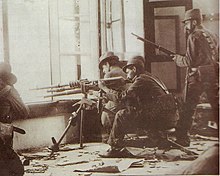Ten Tragic Days
| Ten tragic days | |||||||
|---|---|---|---|---|---|---|---|
| Part of the Mexican Revolution | |||||||
 Rebel soldiers in action during the ten tragic days as they battle for Mexico City |
|||||||
|
|||||||
| Belligirents | |||||||
| (Loyalists) Maderistas |
(Rebels) Porfiristas Reyistas Felicistas |
||||||
| Commanders and leaders | |||||||
|
Lauro Villar Ángel Ortiz Monasterio Victoriano Huerta Ángel García Peña Felipe Ángeles |
Félix Díaz Bernardo Reyes † Manuel Mondragón Aureliano Blanquet Gregorio Ruiz † Victoriano Huerta |
||||||
| Casualties and losses | |||||||
| 5,500 dead | |||||||
| Victoriano Huerta switched from Pro-Madero to Anti-Madero during the ten tragic days | |||||||
The Ten Tragic Days ("La Decena Trágica") was a series of events that took place in Mexico City between February 9 and February 19, 1913, during the Mexican Revolution. This led up to a coup d'état and the assassination of President Francisco I. Madero, and his Vice President, José María Pino Suárez. Much of what happened these days followed from the crumbling of the Porfiriato's system of repressive order giving way to chaos, but it also resulted from the blatant meddling of foreign powers, especially the U.S. Ambassador Henry Lane Wilson. And as such, these days' events have been among the most influential of the Revolution's history. Madero's martyr's death shocked a critical portion of the population, and the unwelcome foreign intervention prepared the way for the growing nationalism and anti-imperialism of the Revolution. In many ways, then, it set the tone for the Revolution's most violent period, but it also prepared the way for an agenda of profound political and social change.
While the bulk of fighting occurred between opposing factions of the regular Federal army, the random nature of artillery and rifle fire inflicted substantial losses amongst uninvolved civilians.
Following uprisings in Mexico in the wake of the fraudulent presidential election of 1910, Porfirio Díaz resigned and went into exile in May 1911. A brief interim government under Francisco León de la Barra allowed for elections in October 1911, and Francisco I. Madero was elected President of Mexico. Madero, a member of one of Mexico's richest families, had never held elected office before.
Within a few months, Madero began to lose support and came under criticism. Though Madero came from a wealthy background, the conservatives never forgave him for driving Porfirio Díaz out of office. Madero’s supporters became disillusioned when he refused to implement their plans, such as the breakup of the large estates. Madero, at the end of his first year in the presidency, faced serious difficulties. The country was to a considerable extent unsettled, the treasury was depleted, and Madero’s staff and supporters were only slightly less audacious than the hated Científicos of the Porfirio Díaz’s era.
...
Wikipedia
